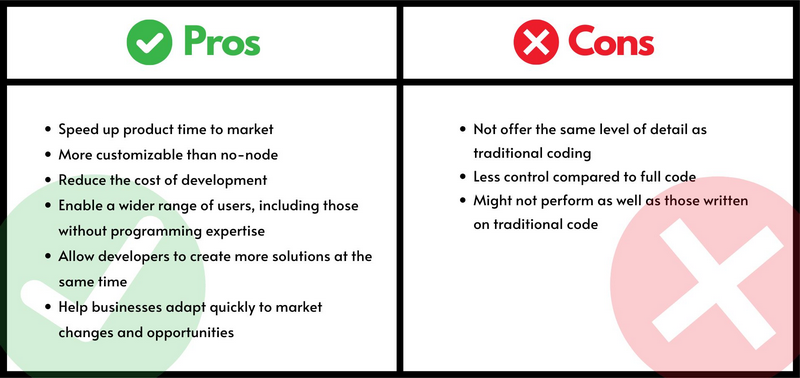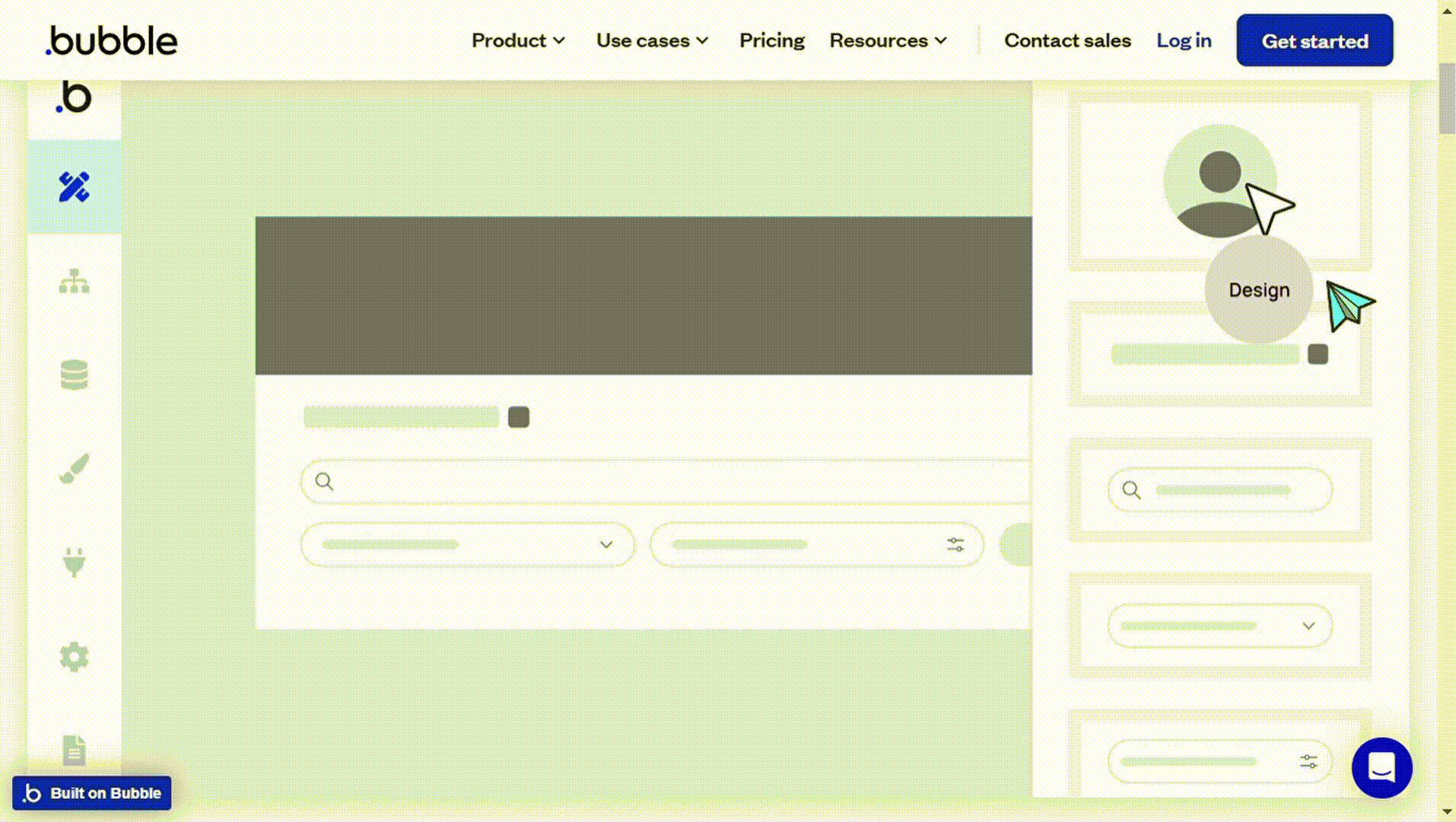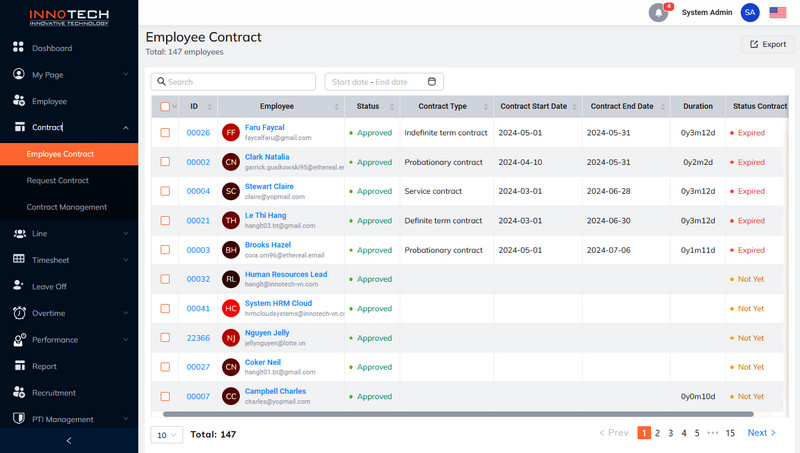The difference between low-code vs no-code platform comes down to how much coding: Low-code may need a bit more for further customization, whereas no-code platforms are designed to run without a single line of code written. However, do low-code and no-code truly deliver on their promise of efficiency and accessibility?
- Low-code platforms power over 60% of app development activities, significantly accelerating development.
- By 2024, Analytics Insight anticipates that 80% of non-IT professionals will build IT products and services, with more than 65% employing no-code tools.
Such implications are important because these methods eat up 70% fewer resources than traditional app development platforms. But which one should you leverage in 2024? Don’t worry, as Innotech experts have done the hard work for you.
A comparison of low-code vs no-code models reveals the nuances of each platform, their impact on the industry, and how they are shaping the future of technology.
Sounds good? Let’s dive in!
Low-code vs no-code: Comparison table
Here’s a quick comparison of low-code and no-code platforms based on 13 criteria. This will make it easier for you to refer back when needed. Additionally, if one of these platforms meets your needs, you can scroll down for a detailed overview, including its pros, cons, and future technological prospects.

Low-code vs no-code comparison table
What is low-code?
Low-code development is a new-age approach in app development whereby the need for traditional coding drastically decreases.
Think of building blocks — each block resembles a piece of code you had concocted. Given an intuitive graphical interface supported by menus, options, and drag-and-drop features, you can choose such blocks.

Magento offers drag-and-drop extensions for low-code solutions.
The low-code platform is versatile because it lets one developer add custom code, if needed, for a unique business function. More than that, it’s helpful for businesses since it allows app development relatively fast without really dipping into deep pockets or requiring extensive programming skills.
As you can see, the above sentences say that low-code platforms empower more people to create apps efficiently, benefiting companies by pushing them to innovate and solve problems faster.
This is great for people who know what they want to do but might not know how to write code. They can still make valuable apps without needing to be expert coders. And for those who do code, it makes things faster as they don’t have to start from scratch every time.
Example of low code platform
WordPress is an excellent low-code platform example, as you can create a website with a breeze by only writing a tiny amount of code. And inside WordPress, you have a built-in code editor to make custom code changes to your website.
WordPress is an excellent low-code platform example.
Pros and cons of low-code
Low-code has been gaining traction due to its ability to streamline the application development. Here’s a balanced look at the pros of low-code and the cons of low-code compared to no code:

Pros and cons of low-code
What is no-code?
Simply put, a no-code is a toolbox allowing anyone to create software or websites without writing any code. These applications provide many visual tools for developing applications, like drag-and-drop interfaces and pre-defined process flows, making apps very accessible.
Besides, low-code vs no-code are made user-friendly and, by nature, designed to complement other systems and processes already entrenched in an organization.

No-code is a toolbox allowing anyone to create software or websites without writing any code.
No-code development is quite flexible and reachable. Therefore, this is the perfect solution for businesses looking to develop their apps fast. Anyone can use them, with or without a technical background. No-code could be valuable for teams trying to innovate and reshape operations without coding every detail.
Pros and cons of no-code platform
Pros of no-code and the cons of no-code compared to no-code:

Pros and cons of no-code platform
Example of no-code platform
Sometimes, in many such cases, the large-scale reports may scare an HR department that is supposed to handle and interpret a vast amount of employee data.
With no code technology, Kingwork HRM by Innotech VN will make your life much easier. You can effortlessly integrate different sources of HR data within a single dashboard with little effort on the coding side.

Kingwork HRM by Innotech VN
With its intuitive nature, the no-code platform helps visualize data without effort, thereby assisting you in getting insights for better business decisions from your side using the approach you use in HR consulting.
This way, you save time for the important stuff and give tools to HR specialists, no matter their technical skills, to become the critical driver of data-driven strategies.
Low-code vs no-code: What are the differences?
Innotech understands that every business has different requirements that could influence our recommendation for the most suitable development approach. While both low-code vs no-code platforms offer streamlined paths to application development, it’s essential to consider the trade-offs in terms of flexibility, customization, and control.
At the end of the day, you’re the expert on your business’s needs. Therefore, using your insight to figure out which development strategy aligns best with your goals is very important.
Below, we’ve compared no-code vs low-code platform across several vital dimensions pivotal for businesses venturing into application development. Let’s take a look!
1. Required skills for each approach
Low-code development is a middle way between classical coding and no-code solutions. It is more accessible to software creation, yet the technical control depth remains.
A programmer has to know programming concepts, though the platform eases the development process by proposing more convenient visual interfaces and already developed components. So, the developer focuses on design and UX. At the same time, custom code can be inserted where needed.
On the other hand, no-code development is for those with little to no coding experience. It helps business users and all the less technical people to build apps through drag-and-drop interfaces and model-driven logic.
So this way, both low-code vs no-code platforms work together and put democratization in the development and creation of apps. But, again, they serve different user bases and levels of complexity.
2. Development speed between no-code vs low-code
Low-code and no-code tools serve as a fast-forward button for app development. For instance, a small business owner, even with basic coding skills, can rapidly use a no-code drag-and-drop tool to build a customer registration portal. This approach can save weeks of development time that would otherwise be spent crafting custom HTML, CSS, and JavaScript.
3. Quality of the application of low-code vs no-code
It is recognized that low-code solutions can help developers tailor applications to meet exacting standards, combining the agility of rapid development with the robustness of traditional coding.
Also, applications developed on no-code platforms can have varying quality and are highly dependent upon the inherent ability of the platform chosen.
However, with astute choice and an intelligent approach to working within the limitations stipulated by the platform, it is well within the possibility to get satisfactory results.
Most no-code platforms today are thorough solutions and deal with security and backend management, thus satisfying enterprises on a big scale. As they develop, these platforms become increasingly high-quality while remaining easy to use. This means the quality difference traditionally associated with ease of development decreases.

Low-code solutions can help developers tailor applications to meet exacting standards
4. Integration capabilities and challenges of low-code vs no-code
In this aspect, low-code platforms provide extensive integration capabilities, similar to traditional coding, but with less complexity. So, with unavailable integrations, some low-code platforms enable skilled developers to create custom integrations through API calls.
Most no-code platforms come with a range of pre-built integrations that cover a wide array of services, such as email marketing, location-based features, and payment processing. The platform providers maintain and update these integrations, relieving users of the responsibility to manage them.
As you can see, both low-code vs no-code platforms aim to simplify the integration process. Yet, low-code platforms offer more customization with manageable maintenance, while no-code platforms provide ease of use with automated support and updates.
5. Financial Considerations
Low-code platforms have been very cost-effective compared to traditional coding since then. Even better, one does not need as big a team of very specialized developers for development.
In this case, the apps can be developed and customized quickly with lower upfront investments. However, some costs will still be incurred for the infrastructure and hosting. But these are many times lower than for traditional development.
No-code goes the extra mile in cost efficiency, where a lot is saved in the time of development and the deployment of resources. They work for small-scale projects, startups, or any business that has to test new ideas quickly with Minimum Viable Products.
By the simplicity of the no-code development process, the barriers to entry are lowered financially compared to those of low-code. Also, subscription-based pricing models used in no-code make it scalable, where the business can adjust investment according to an app’s complexity and usage needs.
6. Security concerns and measures
Security is the most significant element in any application development. After that, security takes on different meanings on both low-code vs no-code platforms.
Low-code platforms offer developers a big deal of control over security protocols, therefore making it possible to give customized security to applications. Even though they automate so much, one is afforded the capability to customize its securities.
By contrast, no-code platforms usually have security features pre-configured. The no-code platforms have evolved to come standard with reasonable security measures that can be sufficient for many projects with no complex demands in terms of security. As a result, choosing good no-code platforms that provide enough security options is essential.

Security is the most significant element in any application development.
7. Support, maintenance, and updates
Both low-code vs no-code platforms make application management less complex than traditional coding.
Low-Code allows for bespoke features that can be added and optimized without full responsibility. Besides, it also allows the development team to easily hold updates and use the platform’s tools to perform actions straightforwardly without losing the capability of doing detailed tune-ups.
No-code platforms make it even simpler. In most cases, maintenance and upkeep are automated. It is most helpful for projects with minimal resource pools or businesses where the core operation is not strictly technical support, as the no-code platform will lift most of the routine burdens.
Getting started with low-code vs no-code development platforms
According to a market survey, 4 out of 5 businesses using low code no code users believe their companies have experienced faster growth thanks to no-code tools.
Adopting a low-code or no-code approach reduces costs and development time, making it an attractive option for businesses aiming to streamline their processes. While low-code and no-code platforms are not substitutes for expert coders and traditional developers, they enable companies to scale in previously unattainable ways, positioning them as powerful tools for the future.
My recommendation? Start with no-code solutions and see if they meet your needs. If they do, you only need to invest heavily in a full-code solution once you’re confident it’s necessary.
Thank you for reading, and we hope these insights prove valuable as you consider the potential of no-code solutions like Kingwork HRM for your business.




